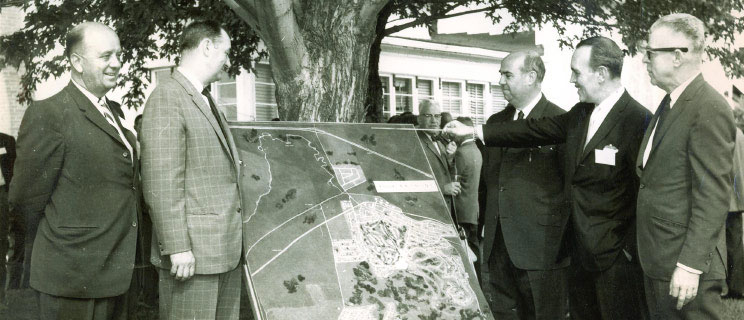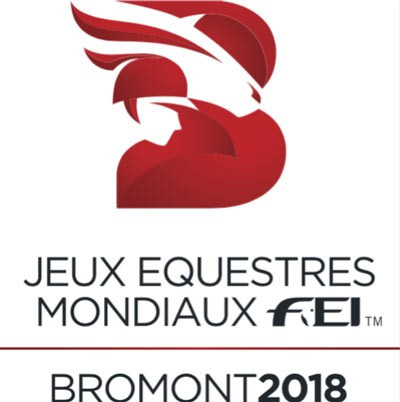With the Bromont bid to host the 2018 World Equestrian Games in the news, I thought it timely to look at Bromont’s horse sport history from its humble beginnings forty years ago as little more than a cow field to its present day world class status.

Show jumping competition photo from the 1976 Olympics souvenir program.
While many former Olympic equestrian venues have come and gone, Bromont keeps on going and growing with no end in sight. While the Bromont history book includes the 1976 Olympic equestrian competitions,* today their annual roster of events feature schooling and Pony Club shows; driving competitions and clinics with notables like Chester Weber; the CCI3* Volvo Three Day Event; the Quebec Equestrian Games and the annual three-week L’international hunter/jumper show.
Bromont, located about an hour east of Montreal in the picture perfect Eastern Townships of Quebec, is a lovely, bustling city that, once a small and quaint village, caught the attention of those wanting a home base within driving distance to Montreal and/or a weekend house in some of the prettiest countryside in la belle province. Minutes from the village, the Bromont Equestrian Centre has become a Mecca for dressage, driving, eventing and show jumping competitions. Add in the cultural mix of Anglophones and Francophones, and a visit to this region is like walking into a small corner of Europe with American and out of province riders coming in droves to compete and loving it! And, for many riders, this author included, competing in an Olympic arena was and is a lifelong dream, even with less than gold medal results.
History of the Bromont Equestrian Centre dates from Désourdy’s dream of olympic proportions.
Bromont Equestrian Centre was originally built by Roland Désourdy, horseman, and entrepreneur businessman, in 1965, as a private club for friends and Montreal Hunt Club meetings. However, with the Olympics looming, Désourdy had a plan, a dream and a vision. Known to all as “Monsieur Roland,” he truly believed that, “If I build it, they will come!”

MM. Pierre-Horace Boivin, M. Roland Désourdy, M. Germain Désourdy, M. Guy Poliquin, M. Aimé Laurion
However, there were obstacles to overcome before Bromont got the Olympic nod. First was a strong competing bid from the Hudson/Ste. Lazare area, another horse enclave to the west of Montreal. Second, when the selection committee arrived, including HRH Prince Philip, President of the FEI, and Lord Killanin, President of the International Olympic Committee, they saw little more than cow fields, swamp lands and meadows, albeit set amongst wooded rolling hills and breathtaking scenery. (Eventually the two lakes located on the present cross country course were dug to drain these wetlands; no doubt today, the environmentalists would have a thing or two to say about that.)
As head of his own construction firm, Désourdy was undeterred by the challenges having built major portions of Quebec roadways around Montreal, sections of the St. Lawrence Seaway and islands for Expo ’67 years earlier. In the end his experience, commitment and vision won the day.
Before the games, Prince Philip asked him about the stadium footing: would it stand up to all the horses? Would it handle heavy rains? Désourdy replied, “Prince Philip I have been building these surfaces all my life, and I guarantee you will have the best footing you have ever seen in this sport.” He and the footing –created long before arena footing was a true science – were as good as his word and the monsoon-like rains of epic proportions that fell on the morning of the individual show jumping competition did not affect the ring at all. It drained in superb fashion, lasted far longer than the Olympic Games, and on that day, thousands viewed the greatest show on earth!

1976 Olympic souvenir program cover. Michael Vaillancourt is at bottom left.
In winning the Olympic bid, Désourdy was just scratching the surface, setting Bromont on its way to becoming a jewel in the crown of the horse world. Désourdy died two years ago, but his legacy lives on in his achievements putting Bromont on the map with golf courses, ski hills, clean industry, high end shops and boutiques, restaurants, and of course the world class Bromont Equestrian Centre.
However, if Bromont was the ship, then a good captain was needed to help steer her course. Enter the face of Bromont, Roger Deslauriers, well known horseman, Level 3 coach, President and General Manager of the Bromont L’international and Chief Executive Officer and Competition Director for the Bromont Equestrian Centre. Phil Rozon, a Level 3 judge who lives near Bromont and is involved with the site and competitions says, “Without Roger, Bromont would have fallen victim to the housing business and none of this would be here today. He took the springboard that was the Olympics and saw much, much more in Bromont’s future. Sue Ockendon also gets credit for organizing the Bromont combined events that draw top riders from North America to compete. ”
After Désourdy’s death Deslauriers recalled, “If it had not been for him, there would have been no Olympic Games in Bromont, it’s as simple as that. We lost someone special, a builder. He always had an extraordinary vision for the future. Places like Cowansville and the Bromont equestrian world just lost a great man. ”
The FEI obituary for Désourdy stated that, “The 1976 Olympic equestrian competitions lifted the level of equestrianism in Canada, leading to the great success the country has enjoyed since Michel Vaillancourt’s individual silver medal in those very Olympic Games and on to Eric Lamaze’s individual gold in Hong Kong in 2008.”
Location, Vision, Leadership = Success!

Bromont today from the air. Photo credit Cealy Tetley.
Part of the success that is Bromont is the organizers’ ability to take a sport, considered elitist by many, and draw newcomers into it. Having a world class rider like Roger’s son Mario as home grown hero also helps to bring out the fans for some good natured interprovincial and international competition. Add to that is that show jumping is exciting to watch and easy to figure out; the grassy hills and fields are ideal for family picnics; the jumps are colourful, complex and creative; and corporate entertaining is always a favourite “job” over the upscale lunches in the stands. No doubt there are countless young riders today who would admit that their initial trip to Bromont was the first step in the, “I want a pony!” scenario.
Bromont, with an eye to the future has made major facility additions and renovations for the past three years including ring resurfacing using the “Otto Sport International” method; water intake; horse showers and new stands to accommodate 4,000 people; and the rebuilding of the Roland Désourdy Pavilion with show offices, bar, restaurant and judges towers.
Also built was an indoor arena adjacent to a stable for 150 horses; and stands for 2,000 visitors for conferences, clinics and demonstrations. The rebuilding works will enable the Equestrian Park to accommodate over 1000 horses. Future plans include an admin centre with meeting rooms and offices.
Today, The Bromont Equestrian Centre Stands Alone

When Roland Désourdy put his dreams and visions into action, little did he know that he was not just creating a world class venue, but launching a venue that was out of this world!
*The team jumping competition was held in the Olympic stadium just before the closing ceremonies.
